It's no secret that the upcoming AMD Vega 10 and 11 graphics cards will challenge the supremacy of NVIDIA thanks to the flagship GeForce GTX 1080 and the hotly-anticipated upgrade, the GTX 1080 Ti. And details known so far indicate that AMD is headed to the right course with the Vega GPU architecture.
One notable feature upgrade that will differentiate Vega from the Polaris platform is in the areas of memory architecture and High Bandwidth Cache, according to WCCFTech. Simply put, Vega will prove more efficient in memory use and allocation when compared to the competition and this applies to both the Polaris and NVIDIA cards.
"An 8GB Vega graphics card, just as an example, will be effectively have as much usable memory as a 16GB graphics card," the report said, pointing to Vega's built-in features of High Bandwidth Cache and the HBC controller. In gaming, for instance, the Vega technology will allocate the amount of memory that a title will actually utilize.
As explained by AMD chief architect Raja Koduri, majority of game titles would list that for optimal gaming experience at least 4GB of memory will be used when playing. But in fact, the game will only use no more than 50 percent of the declared memory requirement. In most cases, the balance of the allocated GPU memory will be rendered unusable.
But with the Vega memory architecture, what the game title will require in terms of actual memory usage High Bandwidth Cache and the HBC controller will certainly allocate, no more and no less. In effect, AMD with the Vega platform has reduced the possibility of wasteful memory use and that is largely due to the High Bandwidth Cache Controller, WCCFTech said on its report.
In real-world application, the 8GB memory demand of a specific game title can be easily handled by a Vega card with only 4GB RAM. So even when an 8GB Vega graphics card is pitted with a 16GB rival card, the former will perform at parity, and again through the wonders of the Vega architecture's High Bandwidth Cache and the HBC controller.
And these Vega 10 and 11 features appear to be the key advantage that GPUs will enjoy over both the NVIDIA GTX 1080 and the 1080 Ti.
Leaked Vega GPU details so far indicate that AMD will deliver the Radeon flagship card with performance capacity of 12.5TFLOLPS and 8GB or 16GB of HBM2 memory with bandwidth of up to 512BGPS. The actual Vega 10 and 11 GPU release date is projected to happen within the first half of 2017, likely as early as March.



























